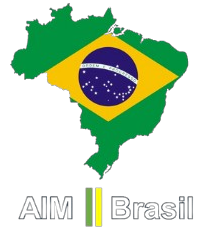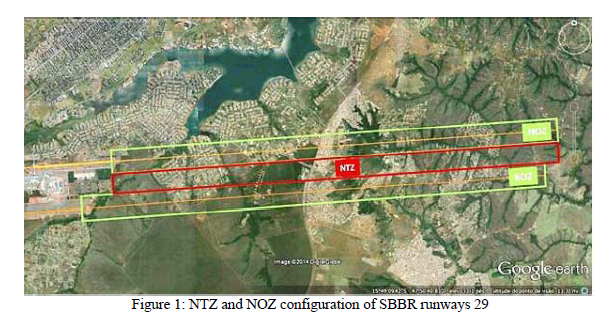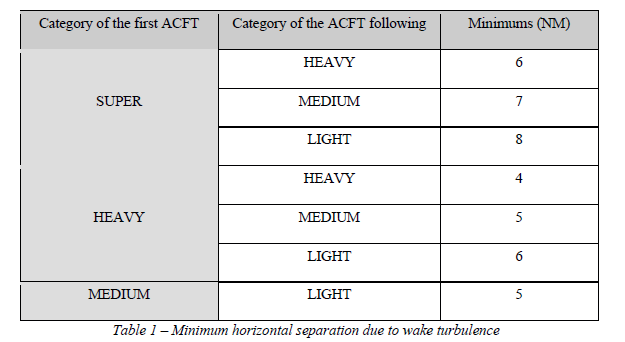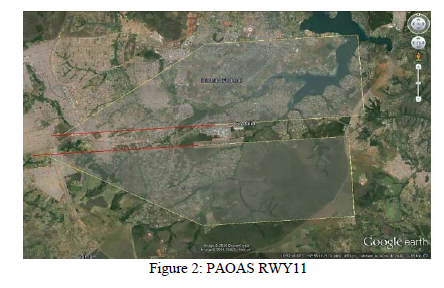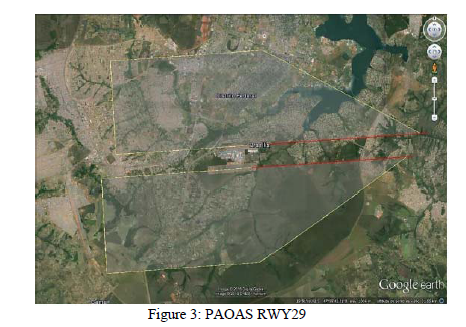The present Aeronautical Information Circular (AIC) aims to inform about the implementation of Independent Simultaneous Parallel Operations (ISPO) at Brasília International Airport (SBBR).
The provisions established in this AIC apply to SISCEAB users involved in instrument approach and takeoff operations at Brasília International Airport.
ICA 100-37 - Air Traffic Services
MCA 100-16 - Air Traffic Phraseology Manual
MCA 100-16 - Air Traffic Phraseology Manual
An aircraft that, after intercepting the final approach path and entering the NOZ, for any reason, deviates from that path. Such deviation does not interrupt the approach of any of the aircraft in ISPA and must be reported immediately to the deviating aircraft by the controller responsible for monitoring the approach.
Aircraft that, after intercepting the final approach path and entering the NOZ, for any reason, deviates from that path and penetrates the NTZ. Such violation causes the interruption
of the approach of the aircraft on the adjacent trajectory.
of the approach of the aircraft on the adjacent trajectory.
Simultaneous IFR approaches on parallel or near-parallel runways, where ATS surveillance separation minima between aircraft on adjacent runway center extensions are not prescribed. The separation between aircraft in such an operation will be guaranteed by the nonviolation of NTZ.
Area located within the CTR or TMA, represented on the ATCSMAC chart, intended for executing the lateral climb profile in instrument departures (SID) or in missed approach procedures (MAP), based on specific heading instructions until reaching the minimum ATS surveillance altitude.
Maneuver performed by an aircraft in SIPA after intercepting the final approach path and entering the NOZ, but without entering the NTZ.
Maneuver performed by an aircraft in ISPD after take-off, in which the aircraft deviates from the take-off axis towards the take-off axis of the adjacent runway)
Maneuver issued by an ATCO to an approaching aircraft in case of a NTZ violation by an aircraft on the adjacent approach. The evasive maneuver may be composed of vertical and lateral maneuvers.
Simultaneous operations on parallel or near-parallel runways in which one runway is used exclusively for approaches and the other is used exclusively for departures.
Simultaneous approaches and take-offs, performed from parallel runways, in which the ATS separation minima are not applied.
APP-BR modulation capability to override the TWR-BR frequency, in the event of a breakout maneuver.
The PAOAS is a set of surfaces established below the ATCSMAC and defined to protect the execution of a breakout.
Maneuver performed by an aircraft in ISPA after the LOC course interception entering the NOZ, violating the lateral boundaries of the NTZ.
In the context of ISPA, the NTZ is a corridor of defined dimensions located between two extended runway center lines, in which a violation by an aircraft requires controller intervention to guide the threatened aircraft on the adjacent approach.
Airspace of defined dimensions that extends to both sides of the approach path. Only the inner half of the NOZ is considered during independent parallel approaches.
2.1.1. First, it is important to point out that the implementation of ISPO at Brasília airport will not have any effect on the operational minima of the procedures involved. The main expected return is the capacity of the airdrome runways.
2.1.2. Crews shall be informed about the performance of the ISPO before the start of the approach or take-off in order to alert them to the need to perform extremely precise maneuvers when intercepting the final approach path or immediately after leaving the ground because, if an aircraft enters the NTZ or turns towards the parallel runway exit path, the other aircraft will be instructed to discontinue the procedure. Information on the start of ISPO will preferably be disclosed through ATIS; if not available, the controller must provide such information.
2.1.3. During ISPO, the crew must pay special attention to avoid approaching the wrong runway or incorrect execution of the initial SID profile, which will cause the need for a breakout of the aircraft on the adjacent runway, with the consequent air traffic incident. Some of the factors that can cause this unwanted approach are:
- Misunderstanding by the pilot regarding the approach clearance or the use of the incorrect approach chart. The pilot does not understand the approach clearance or uses the incorrect approach chart;
- Alignment in the wrong runway on an IFR approach. Such an event can occur too fast and too close to the threshold to allow ATCO action. Therefore, greater attention will be required by pilots when visually identifying the approach runway. The pilot, on an IFR approach, after VMC, lines up to the wrong runway. Such an event may occur too quickly and too close to the threshold to allow ATCO action. Therefore, it will be necessary on the part of the pilots, greater attention when visually identifying the approach runway; and
- SID profile deviation that generates conversion to the take-off sector of the adjacent runway. During a ISPD, the pilot deviates from the SID profile, converging to the takeoff sector of the adjacent runway.
2.1.4. In case of deviations from the expected landing or takeoff trajectories, or any detected contingency, the aircraft will have the procedure in progress discontinued through vectoring instructions, which may be issued by TWR-BR (by delegation of APP) or APP-BR, depending on the flight phase. This procedure may be carried out at altitudes below the minimum ones established in ATCSMAC, as long as the aircraft is within the limits of the corresponding CVA or PAOAS.
2.1.5. During ISPD, the crew must be aware of the profile of the chart. First turn information after takeoff, when published on the SID, will always be for the opposite side of adjacent runway. Another point that requires special attention is the insertion of the SID and confirmation of the selected runway in the FMC. In addition, due to the peculiarities of the ISPD, the pilot must call APP-BR immediately after takeoff.
NOTE: SID charts prohibited for use during ISPD will have a remark about it on its graphic representation area.
NOTE: SID charts prohibited for use during ISPD will have a remark about it on its graphic representation area.
2.1.6. After landing, the runway occupation time must be optimized, and the crew must use the maximum taxi speed that is operationally safe, in order to vacate the runway in use as soon as possible and prioritize the use of fast exit taxiways.
3.1.1. The NTZ is established to facilitate the ATCO's determination of inviolable airspace during the ISPA.
3.1.2. The NTZ determined for the ISPA at Brasília airport is a 680 m wide corridor, established equidistantly between the two center extension lines of the runways. It extends from the nearest threshold to the point where the vertical separation is reduced between AIRCRAFT on adjacent approaches (Figure 1).
NOTE
: If NTZ is violated, controllers must intervene immediately in order to establish separation between aircraft; however, such intervention cannot occur if the aircraft is below 3900 FT. Therefore, it is essential that the crews are attentive and respond promptly to any instructions.
3.2.1. The NOZ is the airspace in which AIRCRAFT are expected to remain while positioning themselves to intercept the final approach path.
3.2.2. There is a NOZ associated with each runway. The NOZ is centered on the runway center line extension line and extends laterally to the nearest boundary of the NTZ. Once stabilized on the final approach path, it is expected that the aircraft will remain in the NOZ without the intervention of the controllers.
3.2.3. The NOZ extends longitudinally from the threshold of the respective runway to the point where the aircraft intercept the extension of the center of the runway. The width of the NOZ is determined taking into account the approach system involved and the capacity of the aircraft to maintain the procedural trajectory.
3.2.4. The width of the NOZ is such that the probability of any aircraft deviating from its limits is minimal. It helps to keep the ATCO's workload low and gives pilots confidence that every action taken by the ATCO is absolutely necessary.
3.2.5. The NOZ established for the Brasília ISPA has a semi-width of 560 m, which meets the requirements for the RNP APCH and ILS procedures.
3.3.1. The ISPA can only be performed under the following requirements:
NOTE: Brasilia Control may assign a specific controller to monitor the NTZ.
- The ILS/RNP systems are fully operational;
- The non-loss of navigation capability (GNSS) of the aircraft OR Maintenance of the aircraft within the coverage area of the GNSS system. The loss of GNSS navigation capability leads to the discontinuation of ISPA;
- Use of instrument approach procedures determined by DECEA;
- ATS surveillance system availability and compliance with the accuracy requirements for the synthesis configuration specified in ICA 100-37. The ATS Surveillance system is available and the accuracy requirements for the synthesis configuration meet the accuracy requirements specified in ICA 100-37;
- Activation and operation of two final control sectors: one for runway 11L/29R and one for 11R/29L. Two final control sectors are activated and in operation: one for runway 11L/29R and one for 11R/29L;
- Provision of air traffic control service using the ATS surveillance system by the final control sectors of both runways. The final control sectors of both runways provide air traffic control service using the surveillance system ATS;
- Isolated and dedicated operation of the final sectors, which must be equipped with specific frequencies (ATCO dedicated exclusively to the sector). Each of the final sectors must be operated in isolation and provided by ATCO dedicated exclusively to the sector, which must be equipped with specific frequencies;
- Two TWR control positions are activated and in operation: one for runway 11L/29R (North Tower) and another for 11R/29L (South Tower);
- That each of the North Tower and South Tower operating positions be operated isolatedly and provided by ATCO dedicated exclusively to the control position, which must be equipped with specific frequencies.
NOTE: Brasilia Control may assign a specific controller to monitor the NTZ.
3.3.2. Situations in which the ISPA will not be carried out or will be suspended:
NOTE : Due to the fact that the aircraft's weather radar shows more accurate information, the pilot must inform the ATC, as immediately as possible, of any need for weather deviation during the final approach, preferably before executing it, so that the ATC can provide the required separation with the aircraft performing the approach to the adjacent runway.
- Meteorological conditions that may cause deviations in the final approach path and resulting in the reduction of the minimum separation;
- Presence of noise or interference in the VHF frequencies used in the final sector and in the frequencies of the North Tower and South Tower control positions, which may impair the clarity and understanding of the transmitted messages;
- Approaching aircraft in emergency, carrying the Head of State or in aeromedical evacuation (TROV/TREN); and
- Reported loss of navigation capability (GNSS); e
- Aircraft flying a different trajectory from the authorized profile after take-off or entering an emergency situation.
NOTE : Due to the fact that the aircraft's weather radar shows more accurate information, the pilot must inform the ATC, as immediately as possible, of any need for weather deviation during the final approach, preferably before executing it, so that the ATC can provide the required separation with the aircraft performing the approach to the adjacent runway.
3.4.1. For the execution of the ISPA, the APP-BR ATCO must inform, as soon as possible, the runway in use and the approach procedure assigned for each of the aircraft.
3.4.2. The ATCO of the final sector position must inform once more the procedure in use and the designated runway for each aircraft, when authorizing the approach procedure.
3.4.3. The pilot-in-command must immediately read back the information received about the runway in use and the procedure to be performed.
3.4.4. The ATCO shall provide 1000FT or 3 NM separation, according to the capabilities of the ATS surveillance system, until the aircraft are stabilized on their respective final approach paths and within the NOZ.
3.4.5. Operators must establish operating doctrines for their pilots, comprising ISPA and CVA.
3.4.6. The crew must adjust the rate of descent of the aircraft, preferably from the beginning of the STAR, so that they can comply with the altitude and speed restrictions provided for in the approach procedure, as incompatible altitudes can cause vectoring to ensure the separation mentioned in the previous item, and consequently undesirable delays.
3.4.7. Breakout is the main means of conflict resolution in ISPA. TCAS, when installed, provides another form of conflict resolution in the unlikely event that other separation patterns fail.
3.4.8. ATC guided breakout instruction provides both vertical and lateral instruction, while TCAS provides vertical maneuver only. During ISPA, if a TCAS Resolution Advisory (RA) alert occurs, crews must always immediately follow this instruction, whenever it occurs.
3.4.9. If, during the evasive maneuver issued by the ATC, the pilot receives an RA, he must comply with the TCAS instructions, inform the ATC and wait for further instructions after the event has ended (clear of conflict).
3.4.10. The interception of the final approach path will preferably be carried out through the RNAV transition provided for in the IAC or through vectoring, if the aircraft does not have RNAV capability. Such vectoring must meet the following requirements:
- Allow the aircraft to intercept at a maximum angle of 30º;
- Provide at least 1 NM of straight and levelled flight before intercepting the final approach course of the procedure in use; and
- Allow the aircraft to stabilize on the final approach path in leveled flight for at least 2 NM before intercepting the glide path.
3.4.11. A minimum longitudinal separation of 3 NM shall be established between aircraft on the same final approach path, unless greater separation is required due to wake turbulence (Table 1) or other reasons such as, for example, a request from the TWR of greater spacing to allow takeoffs.
3.4.12. During ISPA, the ATCO monitoring the final approach must inform the aircraft of any deviation made within the limits of the NOZ. Such deviations will not result in discontinuity of the approach, as long as the deviating aircraft returns to the final approach path before reaching the NTZ.
3.4.13. If a deviating aircraft invades the NTZ, the ATCO must interrupt the approach of the stabilized aircraft at the adjacent final, instructing it to perform a breakout. This maneuver will have a vertical and horizontal component, so that the minimum separation required between the aircraft is established as quickly as possible. The horizontal component of the evasive maneuver may not exceed 45° of the final approach track.
NOTE 1 : If the aircraft are already on the TWR-BR frequency, the evasive maneuver (breakout) will be commanded by the ATCO that is monitoring the NTZ, through the override on the TWRBR frequency.
NOTE 2 : If the monitoring sector is not activated, the evasive maneuver (breakout) will be commanded by the ATCO of the stabilized aircraft approach sector.
NOTE 1 : If the aircraft are already on the TWR-BR frequency, the evasive maneuver (breakout) will be commanded by the ATCO that is monitoring the NTZ, through the override on the TWRBR frequency.
NOTE 2 : If the monitoring sector is not activated, the evasive maneuver (breakout) will be commanded by the ATCO of the stabilized aircraft approach sector.
3.4.14. The evasive maneuver will not be performed below 400FT height in relation to the approach threshold.
3.4.15. O The use of autopilot is encouraged when performing Simultaneous Parallel Approaches. However, it is recommended that evasive maneuvers be performed manually or in accordance with each operator's operational policy, in order to minimize the aircraft's reaction time.
3.4.16. Breakouts performed below the ATCSMAC (chart that establishes safe vectoring altitude) of the TMA-BR are protected by PAOAS. In this way, on the final approach and within the area covered by the PAOAS, the aircraft can be vectored until the vertical or horizontal regulatory separation is established.
3.4.17. The criterion established for the PAOAS analysis was developed to accommodate curves of up to 45º from the approach path with a minimum initiation height of 400FT above the threshold elevation. The assessment also considers that the initial part of the evasive maneuver is performed in the landing configuration, followed by an 8.3% climb gradient.
3.4.18. The SBBR PAOAS has the following configuration:
3.4.19. The criteria established for CVA analysis has been developed to accommodate turns of up to 45º from 3 NM before the threshold in use for landing, with a minimum initiation height of 400 feet above the threshold elevation. For more information on the CVA, refer to CIRCEA 100-120 - “Climbing Vector Area”. The procedures for communications failures as well as the physical characteristics of the area are detailed in the SBBR ATCSMAC.
3.5.1. The ISPD performed in Brasília are based on item 7.2.2.2. of ICA 100-37.
3.5.2. The TWR must inform the aircraft involved in the ISPD operation of the direction of the first turn contained in the instrument departure charts published by DECEA.This information can be transmitted via telephone or via data link, in the traffic authorization in the CLR and reinforced in the take-off authorization to the ISPD operating condition.
NOTE 1:
Aircraft with data link capability may receive the first turn information through the DCL with the message “AFT DEP FST TURN TO RIGHT/LEFT”.
NOTE 2:
Crews should be encouraged to include in take-off briefings, comments regarding the risks associated with the curve or deviation towards the adjacent runway.
3.5.3. The crew, upon receiving the initial information of the first turn, must verify the FMC settings and check procedure selection. Special attention must be given to the selection of the runway in use informed by the TWR-BR.
3.5.4. The pilot must read back the first turn information given by the TWR and, due to the specificity of the ISPD,
the pilot must call the APP immediately after take-off, without command from the TWR (when leaving the ground, or at most, when crossing the opposite threshold)
. The delay in changing the frequency can reduce the time for the APP-BR to alert crews about deviations from trajectories that occurred shortly after takeoff.
3.5.5. If, after the initial authorization, for any reason, the aircraft is authorized to proceed to takeoff on a different runway to the one initially authorized, the TWR must reiterate the information on modification of the exit procedure and on the side of the first turn.
NOTE: The information regarding the authorization of a new runway for take off, departure procedure and first turn must be anticipated as much as possible, in order to allow crews time to select the procedure in the cockpit and check the initial trajectory and take a new briefing related to the new authorization.
NOTE: The information regarding the authorization of a new runway for take off, departure procedure and first turn must be anticipated as much as possible, in order to allow crews time to select the procedure in the cockpit and check the initial trajectory and take a new briefing related to the new authorization.
3.5.6. During ISPD operations, the crew is expected to pay particular attention to the trajectory of the exit procedure, maintenance of the take-off straight and the direction of the first turn after takeoff. If the aircraft's autopilot performs a different trajectory from the authorized one, the crew must react promptly, taking manual control, returning to the expected profile of the authorized procedure and informing the APP as soon as possible.
3.5.7. The take-off trajectory correction maneuvers described in 3.5.6 shall be performed, preferably, manually.
3.5.8. Circumstances for suspension or cancellation of ISPD:
NOTE 1: The aforementioned suspension will be coordinated between the APP and the TWR, and will be informed in a timely manner to the CGNA.
- Adverse weather conditions in the TMA, especially when they affect the SBBR approach and departure paths;
- Presence of noise or interference in the VHF frequencies used in the arrival or take-off sector, which may impair the clarity and understanding of the transmitted messages;
- Loss of aircraft navigation capability;
- Takeoff or approach of aircraft in emergency, carrying Head of State or in aeromedical evacuation (TROV/TREN); and
- Flock of birds in the take-off sector.
NOTE 1: The aforementioned suspension will be coordinated between the APP and the TWR, and will be informed in a timely manner to the CGNA.
3.6.1. The implementation of ISPD at Brasília airport will be carried out gradually, in order to allow a better adaptation of ATCOs and pilots to the new operating standard.
3.6.2. The ISPD will only be initiated after the effective date of this Circular. Initially, ISPD will be conducted only in VMC and during the day. After the transition phase, ISPD will be authorized in IMC and at night.
4.1. This AIC comes into force on 17 APR 2025, revoking, on this date, AIC A 37/24, of 28 NOV 2024.
4.2. Cases not provided for in this Circular will be resolved by Head of the Operations Subdepartment of DECEA.
